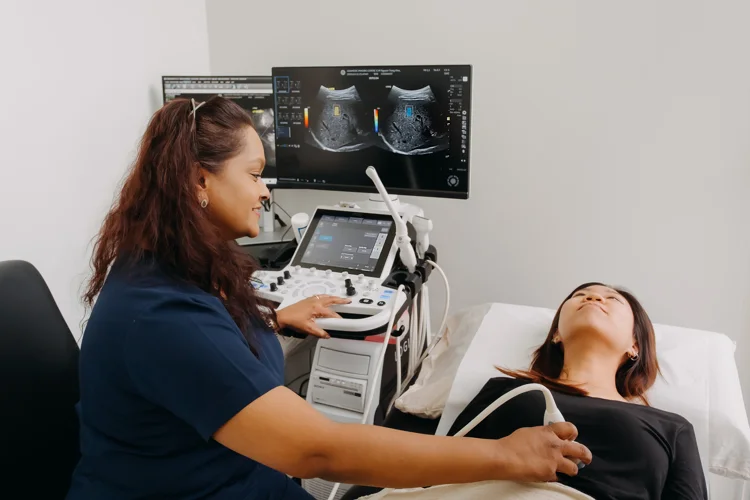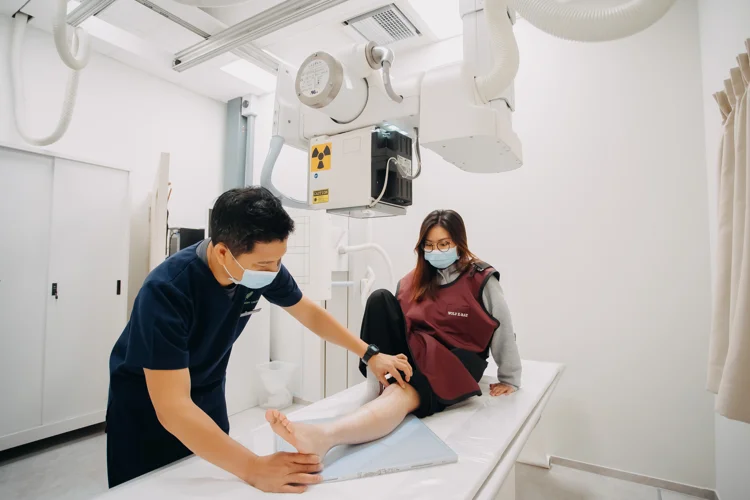How to Test for STDs in the Throat?
A throat swab is a testing method that can be used to detect certain sexually transmitted
infections (STIs), such as chlamydia and gonorrhoea. These
infections can be transmitted through
oral sex, often without noticeable symptoms, making them challenging to identify without
proper testing. In 2018, chlamydia and gonorrhoea were reported as the two most prevalent STIs
in Singapore, highlighting the importance of addressing these infections through early
detection and timely treatment.
Therefore, regular testing is
vital for those who are sexually active.


Potential Symptoms of Throat STIs
Oral STIs can often go unnoticed due to a lack of symptoms. However, some infected individuals may experience signs such as a persistent sore throat, swollen lymph nodes in the neck, fever, or difficulty swallowing. It is important to note that these symptoms are not specific to STIs and could also result from other medical conditions. Therefore, consulting a doctor for a proper diagnosis is essential if these symptoms occur.

Throat Swab Testing: What to Expect
The throat swab test is a straightforward and quick procedure that typically causes minimal discomfort. Here’s what to expect:
- Test Preparation: Avoid eating, drinking, smoking, or using mouthwash for at least 30 minutes before the test. Inform your doctor if you’ve recently used antibiotics or have specific symptoms.
- Sample Collection: You will be asked to sit comfortably and slightly tilt your head back. A doctor will gently insert a soft, sterile swab into the back of your throat, rubbing it against your tonsils and the back wall of your throat to collect a sample. This might cause a slight gag reflex but is usually tolerated well.
- Sample Analysis: The swab is placed in a sterile container and sent for analysis at a laboratory.

Testing Throat Swab Samples
The primary method for analysing throat swab samples is polymerase chain reaction (PCR) testing. This highly sensitive technique can accurately detect the DNA of chlamydia and gonorrhea, even in small amounts. Results are typically available within one to three days. However, throat swab tests are not always included in standard STD testing panels, so it is advisable to confirm their availability with your chosen clinic.

Who Should Get Tested?
Regular testing is
recommended for anyone who is sexually active, particularly those with multiple partners or who
engage in unprotected oral sex. Testing is also important if you suspect exposure to an STD
or are starting a new sexual relationship. Even in the absence of symptoms, periodic
testing is important, as throat STDs are often asymptomatic but still transmissible to sexual
partners.
Additionally, preventive measures
such as using condoms or dental dams during oral sex and maintaining open communication with
partners about sexual
health can greatly reduce the risk of infection.

Summary
Throat swab testing is a useful method for detecting and managing STIs in the throat. Understanding the procedure and recognising the importance of regular screenings for early detection and treatment can help you take proactive steps to safeguard your sexual health. If you’re uncertain about the most suitable testing option, consult a doctor for personalised advice.
Why Choose Us?








Navigate Easy With Google Maps
Health Screening Singapore
(Anson House)
Health Screening Singapore
(Camden Medical Centre)
Frequently Asked Questions (FAQ)
Symptoms of STDs in the throat can include a sore throat, swelling, redness, white spots, or discomfort when swallowing. However, some infections, such as gonorrhoea and chlamydia, might not present any symptoms. It’s also important to note that these symptoms can be attributed to other health issues.
Gonorrhoea, chlamydia, syphilis, and herpes are among the STDs that commonly affect the throat. HPV can also impact the throat, typically being transmitted through oral sex.
Throat STDs may present as redness, swelling, or white patches, but many infections show no visible symptoms. White patches, for instance, could indicate oral thrush (a yeast infection) rather than an STD. If you experience symptoms or suspect exposure, consult a doctor for proper testing and diagnosis.
Yes, a throat swab can test for STDs like gonorrhoea and chlamydia. The swab collects a sample from the throat, which is then sent to a lab for analysis. However, this test is mainly effective for detecting these two STDs; other STDs may require different testing methods.
Throat STDs require treatment with appropriate antibiotics or antiviral medications and typically do not resolve without medical intervention.
The timeframe for STD symptoms to appear in the mouth varies by infection. Gonorrhea and chlamydia symptoms typically emerge within 1 to 3 weeks, while syphilis and herpes may take longer to manifest or remain asymptomatic. It’s important to note that some infections can remain undetected without proper testing.
To detect STDs in the throat, a doctor will take a swab from the back of the throat, which is then tested for the presence of STD-causing bacteria or viruses.
Herpes, HIV, and some strains of HPV are STDs that cannot be cured. While these infections can be managed with medication, they remain in the body for life. Many HPV infections clear up on their own, especially in younger individuals, but persistent cases may cause genital warts or lead to cancers such as cervical, throat, or anal cancer. Vaccination and regular screening are key to prevention.
Bacterial STDs like chlamydia and gonorrhoea can be cured with antibiotics. However, viral STDs such as herpes and HIV are not curable but can be managed with ongoing treatment.
It is challenging to determine if you have an STD without testing because many STDs may not present symptoms. Testing is the only reliable way to diagnose an STD.
No, throat chlamydia does not resolve on its own and requires antibiotic treatment. If you experience symptoms or suspect exposure, consult a doctor promptly to ensure proper treatment and prevent complications.
A sore throat can be caused by various factors, including STDs, allergies, irritants, or other infections. It’s important to seek a doctor’s diagnosis to determine the cause.
No, urine tests are not effective for detecting STIs in the throat. Throat infections require a swab from the throat for accurate testing.
Symptoms may include a sore throat, redness, swelling, white spots, or pain when swallowing. However, many throat STDs are asymptomatic. These symptoms can also result from other conditions, so consulting a doctor for a proper diagnosis is essential.
To test for an STI in the mouth, a doctor typically takes a swab from the inside of your mouth or throat. Testing methods may vary based on the suspected infection, so consulting a doctor is essential for accurate diagnosis and appropriate testing.
